NEXT STORY

Going west before going east – my travels around the world
RELATED STORIES

NEXT STORY

Going west before going east – my travels around the world
RELATED STORIES



When I was doing the mural in Lucknow, the terracotta mural, I had told them that I want to cover the whole façade if I can, but then the architect wouldn’t hear of it, and he showed me spaces where the mural could go, which I didn’t agree to do because all these architects thought of murals as a kind of a minor appendage on the wall, like a postage stamp on the envelope kind of thing. So I said no, I want this kind of space and I will do this. Then we had a big discussion. He didn’t take too kindly to it because I told him that your whole plan is the front façade of the theatre, I was supposed to do mural walls, looked more like a radio cabinet . He was a little hurt by it, but I said, ‘Look, this is why I say, I am not meaning anything bad about it, but then I want to do a long thing, about 81 feet long’, which I did finally manage to do. But I wanted to cover the whole façade if I could. That I have not been able to do. When I was doing the Gandhi Darshan mural in Delhi, I wanted in the beginning to visualise it as a kind of a whole courtyard where three sculptures will stand, and if possible there will be water so that you will have reflections on it. But then they described it, they said if there is water the leaves will fall and it will sort of be messy there, nobody will look after it. So finally I had to think of doing it on dry ground, and those cast cement pieces looking like terracotta as three units, which are still there, not very well looked after, some of it is broken. But then I wanted small trees there, but they have planted a tree that has grown too big and it’s a sort of a big problem for them to contain it. But then after you do a thing, nobody looks after them. Things go into ruin very quickly in a place like India. But at least there, I could do certain things with the whole surrounding because it was a sort of a courtyard. Then, when I was doing it, somebody said - Zakir Hussain, who was then the President of India, died - then somebody came and told me that would you like to do a mural, this thing, if you think in terms of a memorial? I told him it’s an amount of disbelief that look, Zakir Hussain was an academic. He was not a politician, so I wonder whether anybody is going to do a memorial for him, though he was a very distinguished man. But if he did, I would be very happy to do a sort of a whole courtyard with walls surrounding on which I will have sort of a relief mural. If they agree that the memorial should be a rose garden in the middle, nothing else. I had a kind of an idea about this because somewhere I had read that in Persia one of the shahs or chieftains, I don’t know, he was a Sufi, he had died and they had buried with pomp, and then had a sort of a tomb erected over his grave, but he used to haunt everyone who did that and say in their dreams that, ‘Look, I feel choked within this. You break it all down and instead have a rose garden’. So, I said that this is a thing which read somewhere. Maybe that is what he deserves, but it never came true. So, to a certain extent these ideas came readily through. I mean apart from that I have seen such things in India on the temples and things of that kind, and later I have come to see it in what you call other manifestations of Indian temples in South East Asia on a grander scale, whether of the Buddhist or the Hindu persuasion. But then the first temples came from watching the...
From the mediaeval?
The mediaeval.
KG Subramanyan (1924-2016) was an Indian artist. A graduate of the renowned art college of Kala Bhavana in Santiniketan, Subramanyan was both a theoretician and an art historian whose writings formed the basis for the study of contemporary Indian art. His own work, which broke down the barrier between artist and artisan, was executed in a wide range of media and drew upon myth and tradition for its inspiration.
Title: Murals and rose gardens
Listeners: Timothy Hyman
Timothy Hyman is a graduate of Slade School of Fine Art, London, in which he has also taught. In 1980 and 1982, he was Visiting Professor in Baroda, India. Timothy Hyman has curated many significant art exhibitions and has published articles and monographs on both European and Indian artists.
Duration: 5 minutes, 23 seconds
Date story recorded: 2008
Date story went live: 10 September 2010